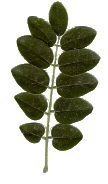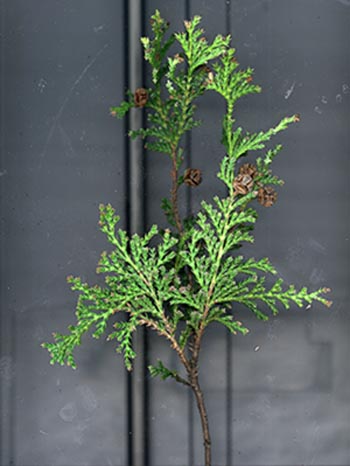Maackia amurensis

|
Baltimore City Forest Conservancy District Board |
|
| Vol. 11, No2 Baltimore |
Maryland
Spring 2002
|

In the meantime, though, the tree may be enjoyed. Its late summer flowers, which appear even in young trees, are white with blue tinges. Dense spikes, panicled racemes, are 4 to 6 inches long. But there is more to admire than the pea-like blossoms. The foliage is beautiful in late spring, as the young silvery, downy leaves contrast with the deep blue-green of young shoots. Alternate leaves are pinnate and up to one foot long. The leaflets, 7 to 11 of them, are pointed, oblong-ovate, and each is about 2 inches long. The fruit of Maackia amurensis is described as semi-elliptic, while the bark is dark brown and somewhat peeling. Above all, the rounded shape, many branches and somewhat shrubby habit make it stand out.
Named for the Russian naturalist Richard Maack (1825- 1886), it was introduced to the United States in 1864. Possibly, our preoccupation with the Civil War prevented the country from a full appreciation of the tree. It is still not often planted, although it is hardy, adaptable and easily grown.
Although there are 10 species of Maackia, M. amurensis the one most often planted. It is hardy from Zones 3 to 7, and has no serious diseases or insect pest. While, like most trees, it favors a warm, sunny location and fertile, well-drained soil, it can tolerate most conditions. Potentially, it is a good street tree. Maackia needs little pruning; any pruning should be done when the tree is quite young. It also transplants readily. Propagation is by root cuttings or by seed. But seeds need to be soaked first in water that is 190 degrees Fahrenheit for 24 hours.
Even if you don't plan to grow Maackia yourself, you should take a look at the Champion at Cylburn Arboretum. It is located by the driveway opposite the mansion.
WILLIAM STINE BRINGS HONOR TO BALTIMORE -IN CHINA

"Nations in Bloom" was started by Alan Smith. Mr. Smith noted in his speech to the gathering of delegates that the standard and quality of all the finalists in 2001 was very high, and that the competition offers an opportunity for the delegates to exchange ideas and to help develop the world's strategy for environmental management.
IN SEARCH OF THE WHITE CEDAR:

What is more rare, however, is the Northern
White-cedar or American Arboruitae.Thuja occidentalis (Northern
White Cedar) is a non- indigenous tree to Maryland with no stands present,
although it may be used as an ornamental. It stands 20 m tall with bark
of thin fibrous and fissured bark and narrow interlacing ridges of a reddish
or grayish brown. It can be identified by drooping sprays of flattened
twigs with brown cones and turns yellow and brownish green in winter. It
is a dense, broad-pyramidal tree with short ascending branches, cones are
oblong and 2 to 5 inchs long and it thrives in marshy loam.
The true Atlantic White-cedar (Chamaecyparis thyoides) has been decimated due to 300 years of boat-building. Leaves are bluish-green with white margins and the tree stands 40-50 ft. tall. Slender in youth the bark ranges from ashy gray to reddish brown and white shaggy in older trees. Cones on small branches (¼ across) are bluish-purple in color. The Atlantic White-cedar was once common in fresh water swamps and bogs.
Diagnosing Soil Problems
An ideal soil is composed of about 45% mineral materials (sand, silt, and clay), 50% pore space, and 5% organic matter, including soil organisms. The pore space in an ideal soil should be filled by roughly equal parts of water and air.
Soils usually consist of several distinct layers which differ in color and texture. The top layer is the organic layer and consists of decaying leaves and twigs. The organic layer is usually found in forest soils, but is absent in most urban environments, or replaced by turf. The next one or two layers usually comprise the top soil. Most of a tree's roots (up to 90%) are usually found in these upper layers at depths less than 2-3 feet. Roots grow best where the soil is relatively loose and moist, meaning there is plenty of pore space filled with water and oxygen. Roots require oxygen for respiration as part of their growth process. If the pore space volume decreases, for example by compaction, less oxygen will be available for the roots, and root growth can decline to the point where the tree's growth is retarded.
Soil types vary by the relative amounts of sand, silt, and clay. Sand particles are larger and sandy soils therefore have larger pore spaces. Water moves through a sandy soil fairly quickly. Silt is made up of medium-size particles. Clay particles are small, so clay soils have small pore spaces and hold water much longer. Soils containing large amounts of clay are much more susceptible to compaction, which simply means that the pore spaces are compressed and no longer able to hold water and oxygen necessary for root growth. Also, soils which contain some clay and organic matter are better able to hold nutrients and are more fertile than sandy soils. Sand can be mixed into a soil to improve drainage.
The pH of a soil measures its acidity or alkalinity, and is measured on a scale of 0 to 14. A pH of 7 is considered neutral. A pH lower than 7 is acidic, and a pH higher than 7 is alkaline. Most trees favor a pH that is slightly acidic. If the pH is too high or too low, the tree roots may not be able to take up certain nutrients needed for growth. If a soil test shows an unfavorable pH, the soil can be modified with lime to raise the pH, or with sulfur to lower the pH.
Soil conditions can also influence water relations. Although clay soils have small pore spaces because of smaller particle sizes, their total volume of pore space is greater than that of sandy soils. Clay soils hold water more tightly and will remain saturated much longer than sandy soils. Water that is held by the soil particles, and has not drained away freely, is available for absorption by the roots. Once this held water has all been absorbed, the tree leaves may begin to wilt. The tree must be watered to restore adequate water relations. Trees that are over-watered or flooded cannot exchange oxygen around their roots because the pore spaces are completely filled with water.
Urban soils often contain various textures of soils. These layers can influence how well water drains from a hole dug for a tree. If a coarse layer (sand) is below a fine layer (clay), water will saturate the upper clay layer before it drains to the lower sandy layer. Likewise, placing gravel in the bottom of a planting hole actually impedes drainage. One of the best ways to improve poor soils is to mix in organic matter such as peat moss.
For technical assistance with tree questions,
contact the Maryland Forest Service (410-665-5820), the Baltimore City
Forestry Division (410-396-6108), the University of Maryland Cooperative
Extension Service (1-800-342-2507), a certified arborist, or a licensed
tree expert company.
Careers Workshop Scholarships
The workshop, located at Camp Hickory in Garrett County, will be held the week of July 29- August 2, 2002. Two students will be selected from each county and Baltimore City to represent that area's Forest Conservancy District Board. The 48 students, working in small groups, will be led by approximately fifteen professional foresters and environmental specialists. The students will have an opportunity to handle technical equipment and participate in tree climbing, water testing, animal tracking, map and compass use and fire control. Call 410 665 5991 for more information
Pigtown Trees and Gary Letteron
The best way to describe Gary is that he is a unique artist, busy painting the city green. Marion Bedingfield, the city's tree specialist, has grown fond of Letteron's guerrilla planting tactics over the past two decades. Bedingfield estimates that Letteron on has planted 3,000 trees over the past 20 years. Letteron uses a fun approach to his work that makes people want to help. His fans say his real value is in motivating urban dwellers to plant, water and mulch their trees which helps to deter violence, trash, and noise. As part of a city school's service learning project, he provided a jackhammer, and the students proceeded to create tree pits in asphalt lots.
The Baltimore City Forestry Board salutes
and supports Gary Letteron.
TREEVIA
What is the difference between a softwood and a hardwood tree? Woods are classified by the lumber industry as softwood or hardwood, depending on the tree from which they come. Woods from broad-leaved trees are called hardwoods, and woods from coniferous trees are called softwoods, regardless of their actual hardness.
Trees such as maples and lindens are classified as hardwoods, even though their wood is relatively soft. A Colorado Spruce and Douglas Fir are examples of softwoods. Most lumber in the U.S. is softwood; the hardwood is generally employed for furniture and high-grade flooring.
Coming Events
The Baltimore City Forest
Conservancy District Board is an advocacy panel to the Maryland Department
of Natural Resources-Forest Service.
Board:
Richard Edson, Chairman
Meredith P. Millspaugh,
Vice Chairman
Tom Green, Treasurer
Russ Moss
Adelaide Rackemann
Elsa Lankford
Associate members:
Gary Letteron
Ann Lundy
Ken Williams
Robert Black
Elspeth Wheeler
Technical Advisors:
Chris Stuhlinger, Secretary
Md. DNR Forest Service
Marion Bedingfield, Forestry
Division Department of Recreation and Parks
Pam Kelly, Executive Director,
State Association MD DNR-Forest Service
Joe Burch, Forestry Division
Department of Recreation and Parks
Amanda Cunningham, Community
Forestry Parks & People Foundation
Jeffery Barrett - Baltimore
City Public School Grounds
Gerard Moudry - Member Emeritus
For more board information,
contact Richard Edson: phone 410 867 1171 or Chris Stuhlinger 410 665 5991
email: loopgaroo@email.msn.com